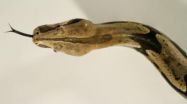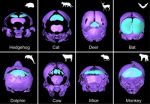Potent human toxins prevalent in Canada's freshwaters
'High microcystin concentrations occur only at low nitrogen-to-phosphorus ratios in nutrient-rich Canadian lakes'
2012-08-14
(Press-News.org) Ottawa, Ontario (August 14, 2012) – Nutrient pollution, one of the greatest threats to our freshwater resources, is responsible for the algal blooms that blanket our lakes and waterways in summer months. Large blooms of cyanobacteria ('blue green algae') can cause fish kills, increase the cost of drinking water treatment, devalue shoreline properties, and pose health risks to people, pets, and wildlife. A new paper just published in the Canadian Journal of Fisheries and Aquatic Sciences shows that microcystin, a toxin produced by cyanobacteria, is present in Canadian lakes in every province.
"Canadians enjoying their summer at the cottage need to know that those green scums of algae washing up on their beach are not only unsightly, but can also be a threat to their health and their children's health," says lead author, Diane Orihel, a researcher with the Department of Biological Sciences at the University of Alberta. "It's time to get serious about cleaning up the nutrients polluting our lakes."
Microcystins are well-established as potent liver toxins to humans and other mammals, and are classified as possible human carcinogens. "Blue-green algae present a growing health concern for domestic, agricultural and recreational water use in Canada and world-wide", warns Dr. David Kinniburgh, the Director of the Alberta Centre for Toxicology at the University of Calgary. "The microcystin toxins they produce can cause acute liver failure in humans and may even cause cancer with long-term exposure."
This study is the first to report on microcystin prevalence at a national scale–data from 246 bodies of water across Canada were collected. The authors determined that water quality was most at risk in lakes with the highest concentrations of nutrients. Nutrient-rich lakes and reservoirs, particularly in central Alberta and southwestern Manitoba, proved to have highest toxin concentrations, though all regions in Canada contained lakes that reached microcystin levels of concern.
A very important finding–that calls for further research–was the strong association between low nitrogen-to-phosphorus ratios and high microcystin concentrations. The authors recommend whole-ecosystem experiments be performed to understand how changing nutrient inputs to lakes affects microcystins and other cyanobacterial toxins. This information is essential for governments to develop effective management strategies for improving water quality in nutrient-polluted lakes.
"Harmful algae blooms are a growing problem worldwide. The more we look, the more we find," remarked international water expert Dr. Stephen Carpenter, Director of the Center for Limnology at the University of Wisconsin-Madison, "Orihel and colleagues help define the conditions when we would expect highly toxic freshwater. These insights make it possible to focus management and research on the highest-risk situations."
"This study addresses an issue that has important health consequences, but also highlights the importance of both the underlying basic science and monitoring programs essential to determine environmental changes," says Don Jackson, Co-Editor of the Canadian Journal of Fisheries and Aquatic Sciences.
INFORMATION:
The paper "High microcystin concentrations occur only at low nitrogen-to-phosphorus ratios in nutrient-rich Canadian lakes", published in the Canadian Journal of Fisheries and Aquatic Sciences, is available Open Access at http://www.nrcresearchpress.com/doi/full/10.1139/f2012-088
END
ELSE PRESS RELEASES FROM THIS DATE:
2012-08-14
A novel virus has been identified as the possible cause of a common but mysterious disease that kills a significant number of pet snakes all over the world, thanks to research led by scientists at the University of California, San Francisco (UCSF)—and three snakes named Juliet, Balthazar and Larry.
The virus, previously not thought to infect snakes at all, appears to cause "inclusion body disease." Long the bane of zoo officials and exotic pet owners, the deadly illness spreads among boas and pythons in captivity, causing micro clumps of clustered proteins to form inside ...
2012-08-14
Researchers at Moffitt Cancer Center and colleagues at the University of South Florida have discovered a mechanism that explains how some cancer cells "hijack" a biological process to potentially activate cell growth and the survival of cancer gene expression.
Their study appeared in a recent issue of Nature Structural & Molecular Biology.
The newly discovered mechanism involves histones (highly alkaline proteins found in cells that package and order DNA), and in this case, histone H2B, one of the five main histone proteins involved in the structure of chromatin. Chromatin ...
2012-08-14
VIDEO:
Researchers at the La Jolla Institute for Allergy & Immunology have identified the specific type of immune cells that orchestrate the inflammatory attack on the artery wall, which is a...
Click here for more information.
SAN DIEGO – (August 14, 2012) – Most people probably know that heart disease remains the nation's No. 1 killer. But what many may be surprised to learn is that cholesterol has a major accomplice in causing dangerous arterial plaque buildup that can ...
2012-08-14
Whilst the most powerful earthquake since records began hit Japan in 2011, triggering a massive tsunami which devastated much of the country, space scientists involved in one of the 'brightest' international Sun missions continued working tirelessly at the Institute of Space and Astronautical Science in Sagamihara, Japan, to capture new data from our turbulent star.
These latest Hinode results, to be discussed in a meeting at the University of St Andrews this week (Tuesday 14 August), include new data on the structure of the Sun's coronal magnetic field, obtained whilst ...
2012-08-14
Guided press tour
The excavation will be open to the press on Wednesday 15 August from 13.00 to 15.30.The tour starts at Alkenvej 171, 8660 Skanderborg.
...
2012-08-14
Sulphur dioxide emissions from shipping have sharply decreased in EU ports thanks to an EU policy which limits sulphur content in fuels for ships at berth or at anchor in ports. Scientists at the European Commission's Joint Research Centre measured key air quality parameters in Mediterranean harbours before and after the entry into force of the low-sulphur requirements in January 2010. In European harbours they found an average decrease of 66% in concentrations of sulphur dioxide, a chemical compound that poses risks to health and the environment. Measurements taken in ...
2012-08-14
People who give positive encouragement and constructive criticism could be wasting their breath according to the latest research from a psychology expert at Queen Mary, University of London.
The study, published in the journal Frontiers in Neuroscience, found that when people received either positive or negative feedback about their performance on complex decision-making tasks, it made their decision making worse.
Study author Dr Magda Osman explained: "The kind of task people had to perform was difficult and demanding. So, when people received positive or negative ...
2012-08-14
The mammalian skull, including that of people, is composed of about 20 bones. Fish, reptile and bird skulls, however, have considerably more. After all, when mammals evolved from reptile-like vertebrates 320 million years ago, the skull's structure became simplified during its development and the number of skull bones decreased.
Some bones were lost in the lineage leading to mammals in the course of evolution, especially a number of skull roof bones. The skull's interparietal, which is one of the skull roof bones, particularly puzzled researchers: on the one hand, it ...
2012-08-14
They're sleek. They're fast. They're powerful. And, they are deafening. Furthermore, those Top Gun military jets need to be up in the air in the wee hours – over land – to simulate their landings on aircraft carriers. But innovations out of the University of Cincinnati's Gas Dynamics and Propulsion Laboratory are showing promise in reducing the intense noise of these supersonic jets without impacting their power. It's research that can help neighborhoods slumber a little more soundly, keep their windows rattling a little less loudly and also protect the hearing of military ...
2012-08-14
University of Cincinnati research – from noise reduction in sophisticated military jets to quieter car rides – will be presented at INTER-NOISE 2012, the 41st International Congress and Exposition on Noise Control Engineering, to be held Aug. 19-22 in New York City. UC is among only a few universities with a specific focus on vehicle noise control.
The UC research to be presented at INTER-NOISE:
UC innovations to reduce the noise of the nation's most sophisticated military aircraft. Jeff Kastner, research assistant professor in the UC College of Engineering and Applied ...
LAST 30 PRESS RELEASES:
[Press-News.org] Potent human toxins prevalent in Canada's freshwaters
'High microcystin concentrations occur only at low nitrogen-to-phosphorus ratios in nutrient-rich Canadian lakes'



